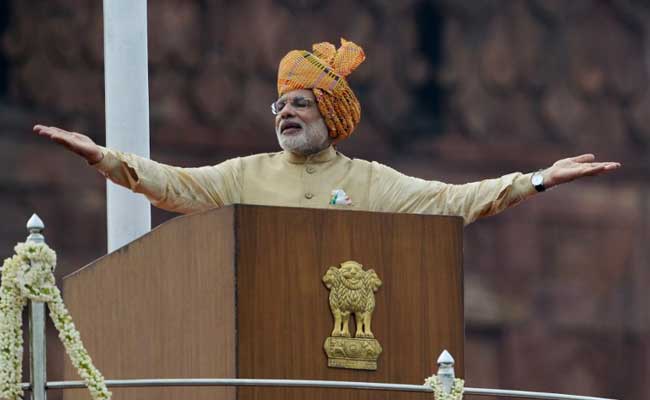Yet, would such an interpretation be entirely fair? In 2014, Modi was speaking just three months after a pulsating election victory. The fact that he spoke from his heart, free of the stilted delivery and notes of the past 10 years, if not longer, and that he had no legacy to explain or worry about worked to his advantage. It was a blue-sky speech; he could place the stars where he wanted.
A year down the line, the sky is not as clear. It cannot be; inevitably, the clouds will appear. In that sense, this was a more "normal" Prime Ministerial speech. One hesitates to use the word "normal" because frankly one is judging Modi by his own oratorical standards. Both his speeches remain superior to those of not just his immediate predecessor but many Prime Ministers.
To some degree, Modi was addressing the mood of despondency that he said his critics - in which he implicitly included political opponents and media pundits - were creating, and sought to dispel the notion that his government had not done much. Depending on how one looks at it, this was a defensive or combative move.
It carried forward a bet that Modi had taken during his long pre-election campaign: that he could use television-friendly moments to address his people directly, bypassing the transmission loss and interpolation of the media. Here, too, he was telling his constituency and his citizens that his report card, while it had its shortcomings, was still markedly better than that being portrayed by some sections.

Three points stood out in the speech. First, Modi sought to link the rolling back of corruption to not one or two blockbuster initiatives but a longer process - of auctions of public resources (which the Modi government has extended to resources beyond coal, the commodity for which auctions were mandated by the courts); of doing away with subjective job interviews where this is feasible; of bank accounts and direct bank transfers of subsidies for the needy, cutting out the middleman; of changing the culture in government bhawans of central Delhi, where room-service operations of well-known fixers have declined in the past year.
True, much remains to be done, and the Prime Minister acknowledged that, without explicitly mentioning Vyapam or any other newsy issue. Nevertheless, the thrust of the message was on a long-drawn battle that would require patience. His backing of tough black money regulations, which many feel give too much authority to the taxman, was vintage Modi: willing to defend an unpopular cause if he feels this is right in the longer term. This is exactly what he did with power reforms in Gujarat.
Second, Modi didn't fall into the trap of new announcements and projects. Rather, he focused on many issues that had found mention in 2014 and on other occasions - Swacch Bharat; a better deal for farmers, including in terms of irrigation technology ("per drop, more crop"); toilets in schools and in public spaces; power available 24/7; dignity of labour and a need to see manual and low-skilled workers with the respect that is often denied to them in India's hierarchical society.
He was repeating these because delivery is a work-in-progress. It can be substantially achieved in a five-year time-frame, maybe even longer. More important, it remains a commitment he is wedded to. He was not going to replace these promises with new ones just to decorate another August 15 speech. He was going back to his own benchmarks and will presumably continue to do so in the remaining years of his term.
Third, there are those who consider Modi's emphasis in many paragraphs to the underprivileged as a conscious effort to dissociate himself from big business and a response to Rahul Gandhi's "suit-boot" dig. If so, this again would be out of character for a long-haul navigator. While a quarter of India's people certainly do live in poverty and need help, key parts of Modi speech were devoted to the much larger segment just above the absolute poor but well below the middle classes. These are those he called the "neo-middle classes" in his campaign period.
This group has risen out of poverty in a generation and represents those with aspirations - to borrow from the imagery the Prime Minister constructed in another example - to move from coal stoves to LPG cylinders. This group comprises those with some capital to spare but only a little - though still enough to park Rs 20,000 crore in 170 million Jan Dhan Yojana bank accounts.
This bottom-of-the-pyramid class were those Modi sought to reimagine as consumers, as risk-takers (those in the informal sector are often more entrepreneurial than business tycoons who invest only what banks and financial institutions give them), as job creators who should be given a fillip to begin small start-ups, even a little shop or repair centre. These are the mom-and-pop businesses that, should they begin to blossom, could revolutionise India. This remains Modi's social goal.
All in all, Modi has moved from the pinch-hitter of year one to the solid middle-order batsman of year two, determined to build the innings. The coming years will tell us if he reaches a century or falls in his thirties or forties. This speech told us he was alive to the need to dig himself in.
The rest is delivery - and destiny.
(The author is senior fellow, Observer Research Foundation. He can be reached at malikashok@gmail.com)
Disclaimer: The opinions expressed within this article are the personal opinions of the author. The facts and opinions appearing in the article do not reflect the views of NDTV and NDTV does not assume any responsibility or liability for the same.


